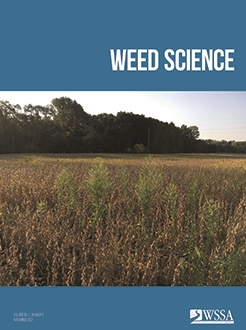Photosystem II (PS II)-inhibitor herbicide resistance in Ontario waterhemp [Amaranthus tuberculatus (Moq.) Sauer] populations is conferred via target-site resistance (TSR) and non–target site resistance (NTSR) mechanisms. Metribuzin-resistant (MR) A. tuberculatus is due to TSR. Conversely, in other populations of PS II–inhibitor resistant A. tuberculatus, plants are resistant to atrazine but metribuzin sensitive (MS). The objective of this study was to determine the biologically effective dose of metribuzin applied preemergence and postemergence for the control of MS and MR A. tuberculatus. Ten field experiments were conducted in 2019 and 2020 to determine the effective doses of metribuzin for 50%, 80%, and 95% control of MS and MR A. tuberculatus. Metribuzin applied preemergence at the calculated doses of 133, 350, and 1,070 g ai ha-1 controlled MS A. tuberculatus 50%, 80%, and 95%, respectively, whereas the calculated doses of 7,868 and 17,533 g ai ha-1 controlled MR A. tuberculatus 50% and 80%, respectively, at 12 wk after application (WAA). Metribuzin applied postemergence at the calculated doses of 245 and 1,480 g ai ha-1 controlled MS A. tuberculatus 50% and 80%, respectively; the calculated dose for 50% MR A. tuberculatus control was greater than the highest dose (17,920 g ai ha-1) included in this study. Metribuzin at 560 and 1,120 g ha-1 and pyroxasulfone/ flumioxazin (240 g ai ha-1) applied preemergence controlled MS A. tuberculatus 88%, 95%, and 98%, respectively, at 12 WAA, whereas the same treatments only controlled MR A. tuberculatus 0%, 4%, and 93%, respectively, at 12 WAA. Metribuzin at 560 and 1,120 g ha-1 and fomesafen (240 g ai ha-1) applied postemergence controlled MS A. tuberculatus 65%, 70%, and 78%, and MR A. tuberculatus 0%, 1%, and 49%, respectively, at 12 WAA. Based on these results, PS II–inhibitor resistant A. tuberculatus with NTSR (enhanced metabolism) is controlled with metribuzin applied preemergence and postemergence; in contrast, PS II–inhibitor resistant A. tuberculatus with TSR (glycine-264-serine altered target site) is not controlled with metribuzin.
How to translate text using browser tools
30 July 2021
Biologically Effective Dose of Metribuzin Applied Preemergence and Postemergence for the Control of Waterhemp (Amaranthus tuberculatus) with Different Mechanisms of Resistance to Photosystem II–Inhibiting Herbicides
David B. Westerveld,
Nader Soltani,
David C. Hooker,
Darren E. Robinson,
Patrick J. Tranel,
Martin Laforest,
Peter H. Sikkema
ACCESS THE FULL ARTICLE

Weed Science
Vol. 69 • No. 6
November 2021
Vol. 69 • No. 6
November 2021
BED
glycine-264-serine altered target site
photosystem II–inhibitor resistance
weed management





